
Ready for a hard long day, a border to cross, and numerous police checkpoints, or so we were led to believe, we set off in the dark along quiet dark roads of Ziguinchor. Men were emerging from the mosque and queuing up at the sandwich stall. Gentle singing could be heard over the loud speaker as individuals recited religious melodies. Even the call to prayer here is gentle, not being in Arabic, but in a local language, maybe Diolla, as this their land. Our journey will take us through many lands of different groups of people. The countries’ borders don’t represent the change in these groups as they are arbitrary lines on a map fought out by colonial powers back in history.
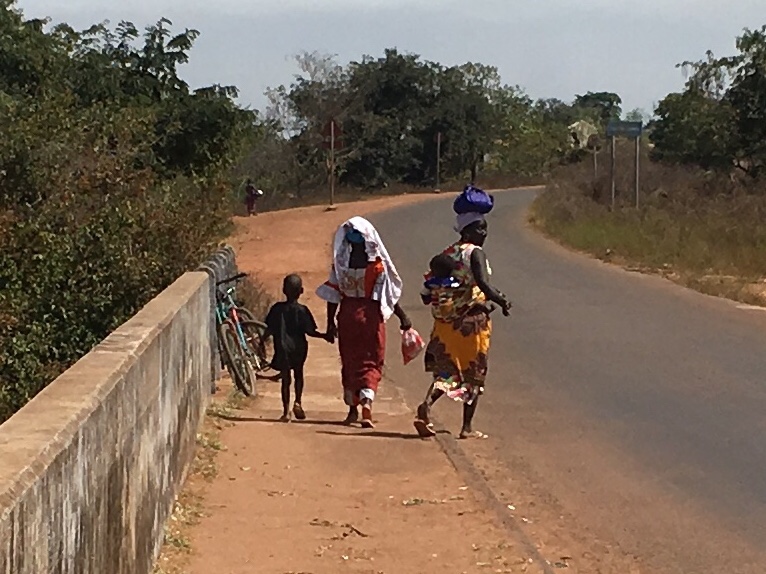
Soon we are out on the open road as the sun starts to rise silhouetting the tall trees and arching palm fronds, bringing a little heat to the morning chill. Elegant women wearing brightly coloured clothes, so typical of West Africa, walk along the road side edge carrying large loads on their heads. Children are cycling and walking to to school, chatting away in small groups. Beaten up vehicles pass packed full of people.
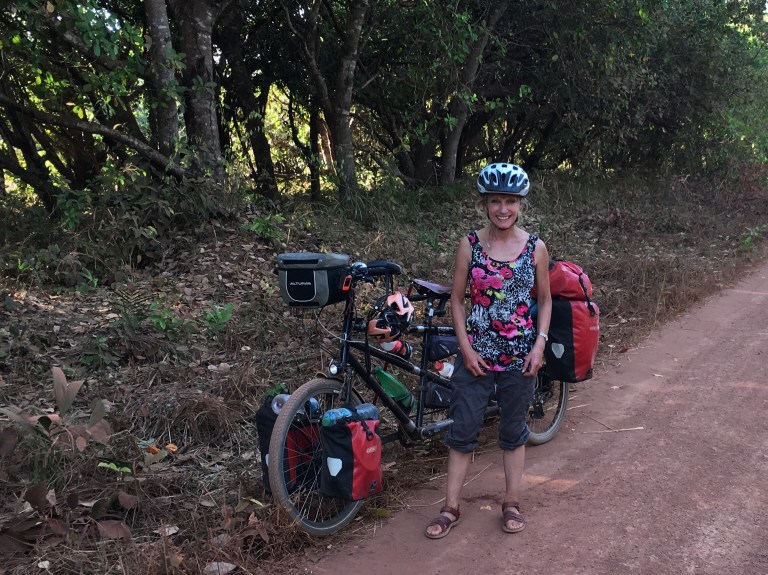
The border is a very swift affair, and although locals are requested to pay a small fee, our entry stamps went in without a quibble.
We were in Guinea-Bissau, a new country, and people seemed even more friendly than Senegal. When you cross a line on the map it’s always surprising the differences you see, when basically they are the same people that have just been separated and experienced different systems and regimes. They noticed us more and called out cheerfully “bravo bravo” as we cycled past. Villages were better kept, more colourful, orderly, with more mud houses that had verandas all the way round. Some even had gardens and hedges, others had painted the mud render blue or pink. People sat on their verandas passing the time of day, children played, and youths sat under the shade of trees listening to reggae music. It was a gentle communal scene.
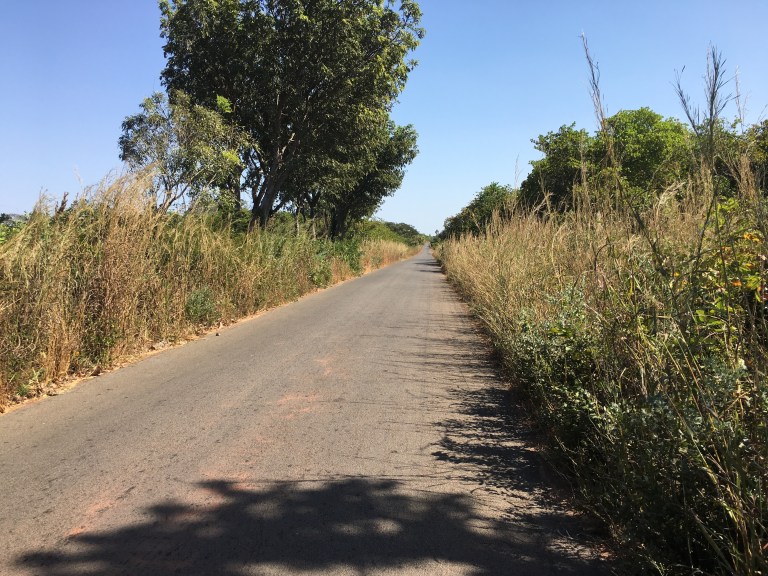
The road was quiet and we cycled through cashew plantations. At times the long grass and trees of the bush closed in on the road.
It’s a long haul in the heat, but we push onto the capital city Bissau. Police checkpoints, talked about in Senegal didn’t really exist for us. Relaxed people sitting in the shade chatting, waving to us, and calling ca va. Maybe they become more alert when they see the fat pickings of a smart car, but for us it was a broad smile and a wave.
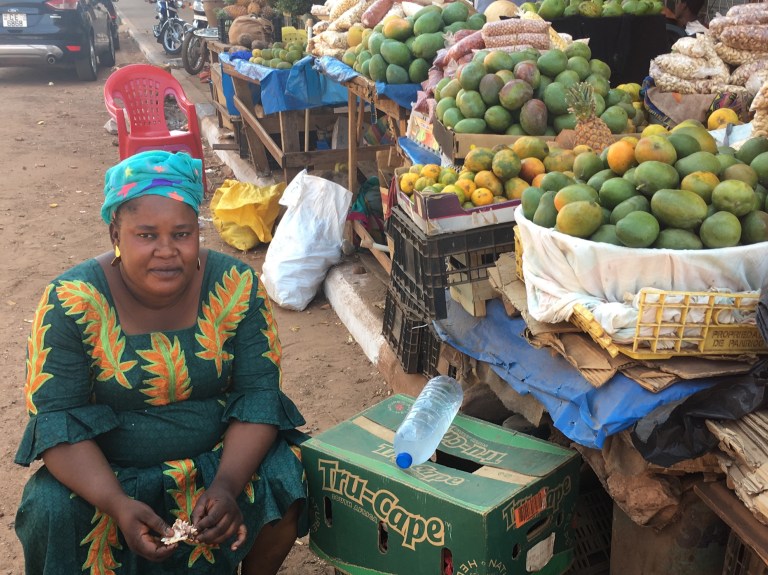
At Bissau we had to cross the wide expanse of the Rio and had to wait an extra day for the ferry as there was a public holiday to celebrate Amilcar Cabral, an activist that fought for independence, but who unfortunately was assassinated the year before independence was won.

Bissau is a very quiet capital city with wide tree lined avenues, empty of people and cars. Dilapidated Portuguese buildings make up some of the old town adjacent to the large old fort, still used as a military campement, and the home to Amilcar Cabral’s tomb. Portuguese people sit solemnly around cafes smoking and drinking coffee, not a lot of chatting, just passing the time of day. “Bonjour, ca va” we say, “comme-ci, comme-ca, comme-Bissau” was their grunted reply. The town had a ghostly feel, but we met some good people and had some nice chats.


We were staying at the house of a local actress, Lisa, who is a lovely bubbly lady. She had recently made a film which she was the lead. It was about her mother who had been given away as a child, for the hope of a better life, due to her family’s poverty. Sadly her adoptive family were bad and treated her like a slave. Lisa plays her mum in the film and it has a happy ending.

With the wide Rio to cross we got down to the docks early before sunrise to wait for the ferry. The port was an eerie place with rusting boats tied alongside the wharf and very few people about. As the light came up we were lead along the wharf and soon climbing over rather dilapidated ships with Greek writing on to get to our ramshackle of a ferry. You wondered where these boats had originated from before this part of Africa. Probably they have done a full service in the Greek islands and then sold for scrap, but still life in them for West Africa. We have to climb up and down stairways and over railings carrying our tandem and panniers. It is hard going and precarious as the bike goes from one ship to another. A large rat runs out from a holey tarpaulin on the rusty deck. Women carrying all sorts of things on their heads, and babies on their backs make the same climb. We are on the boat as the sun rises over over the Rio waiting with the brightly dressed ladies.
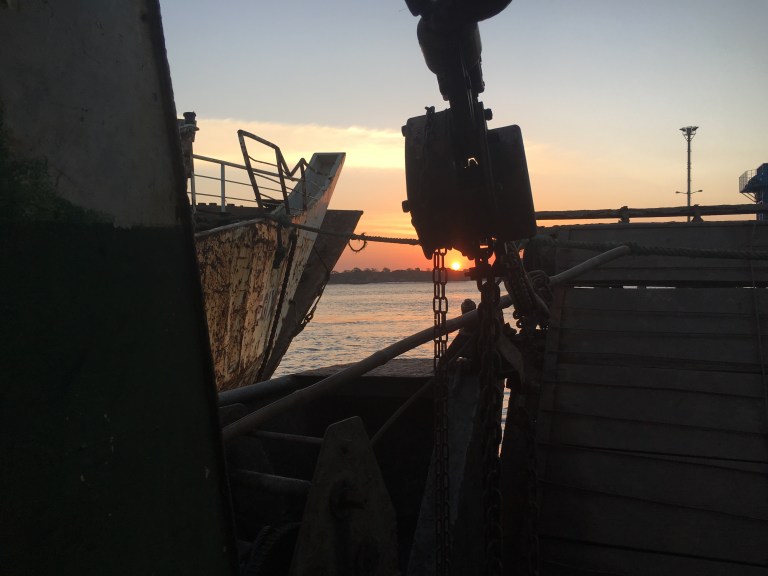
Then it is decided the boat will not run! Oh no we now have to make the climb back to the wharf and over to a fishing boat that has taken on the job. More and more stuff is loaded, sacks of rice, fuel, live pigs and goats. Eventually three hours after getting to the port, we pulled away from the quayside and slipped out into the Rio. The tide was running strongly and the fresh wind whipped the water into quite a chop. The boat was pitching and rolling, and spray was thrown over from the bow as we smashed down on a steep wave. We huddled down behind the boats wheel house next to a mother breast feeding her child and a goat tethered to a fish crate. 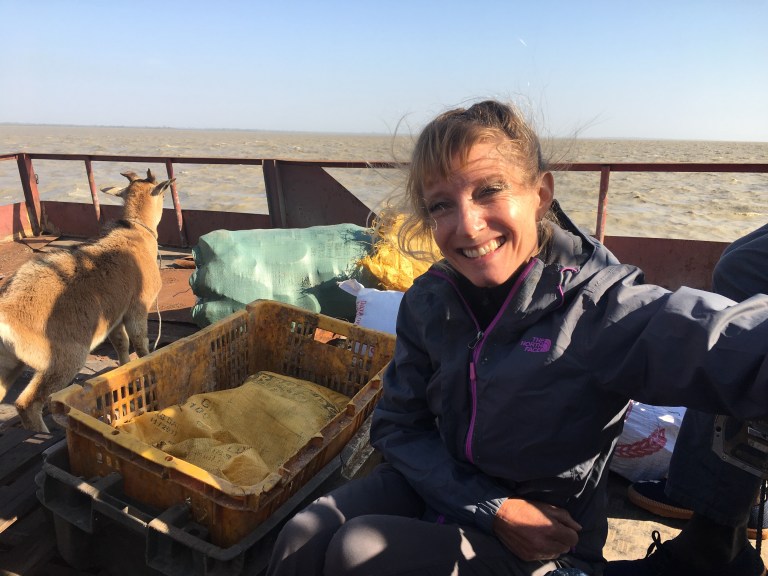
Once on the other side, an hour and a half later, the water calmed and the boat motored into an inlet and skilfully manoeuvred onto the end of a concrete ramp. There was a lot of commotion at the simple dock. A crowd of people with all their goods, pushing to the waters edge as we came too. A tricky climb down and the bike was passed over the human chain as we disembarked.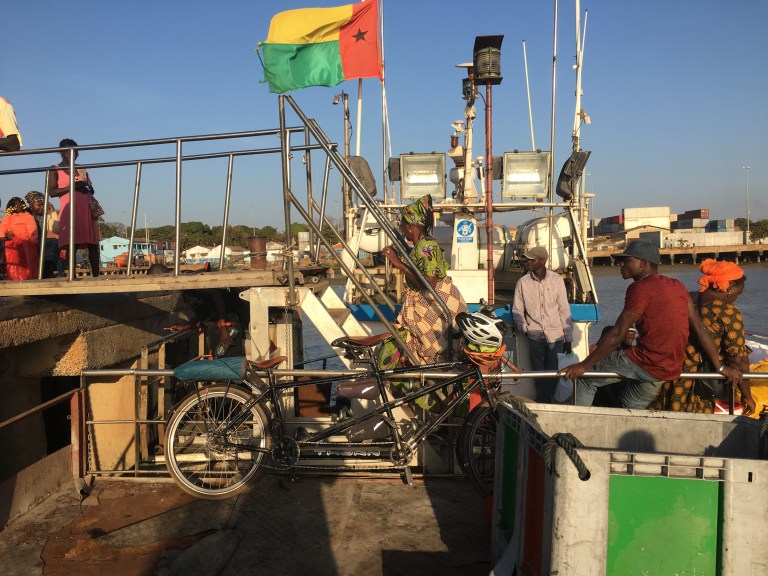

Once clear of the water’s edge we were back on the road cycling along a red gravel track. There was silence again, only interrupted when we passed villages every so often, and the normal exchange of greetings that followed. The road was rough and rutted. Forest on either side. Sometimes we fought with the sand, other parts were quite good. The villages as tranquil as ever, tidy mud houses, some with thatched roofs some preferring shiny corrugated steel. Groups of people sat around chatting, waving at us as we passed by. The red dusty track went on and on into the distance up and over small hills, the red dust cut its way through the forest. As we approached villages or markets in the distance, there are groups of graceful, elegant women carrying large loads on their heads, walking along the track, beautiful and with perfect posture, they make for a truly African scene.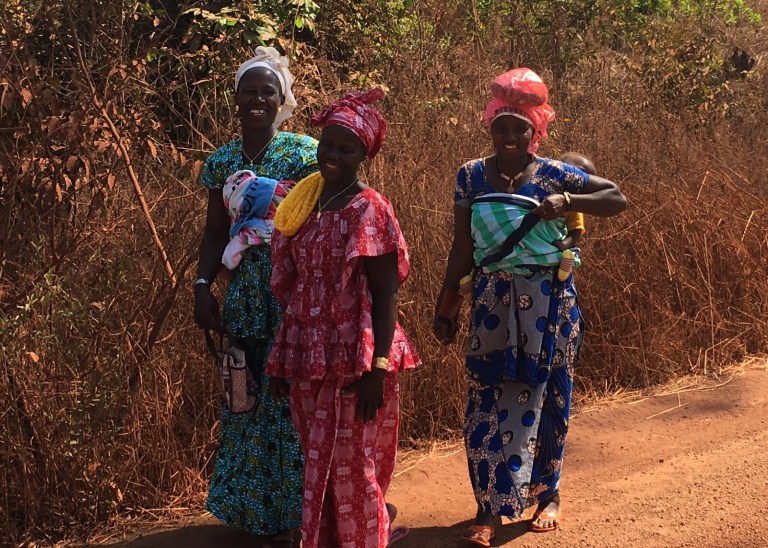
We stay the night by a wide river set in lush tropical vegetation. The river pours over large rock slab steps forming impressive disturbed turbulent whitewater. The roar fills the air. As the evening came in, the boulders in the river glinted orange and the surrounding forest looked unexplored.

We were joined by a large group of French overlanders who were driving from France to Guinea and back. They were a really friendly bunch, all in their 60s and 70s, and we exchanged many stories during the evening.
 We left as the sun was rising for the Guinea border . The good laterite track lead us to a village where a small earth piste turned off in the direction of Guinea. Almost unnoticed a uniformed man sitting outside a simple shop called out ” immigration” this was the exit frontier of Guinea-Bissau. After a delay whilst he returned to his house to collect his bag and rubber stamp he began the slow task of reading our passports. Pages turned slowly, and eventually the stamp was applied, after he had spat on the dried up old ink pad to try and get it to work.
We left as the sun was rising for the Guinea border . The good laterite track lead us to a village where a small earth piste turned off in the direction of Guinea. Almost unnoticed a uniformed man sitting outside a simple shop called out ” immigration” this was the exit frontier of Guinea-Bissau. After a delay whilst he returned to his house to collect his bag and rubber stamp he began the slow task of reading our passports. Pages turned slowly, and eventually the stamp was applied, after he had spat on the dried up old ink pad to try and get it to work.

We set off on the narrow track that lead deep into the forest. Sometimes it narrowed down to a path and we passed through many villages with round mud huts and grass thatch. Rickety bridges and fords were crossed as the day went on and the heat built up. The vegetation hung thickly over the path giving us shade that alleviated the harsh heat of the day. Eventually we arrived at a Guinean flag and a man sitting under the shade of a grass thatched timber structure on the edge of a very pretty traditional village. He checked our visas and told us to get our passports stamped after we cross the river.
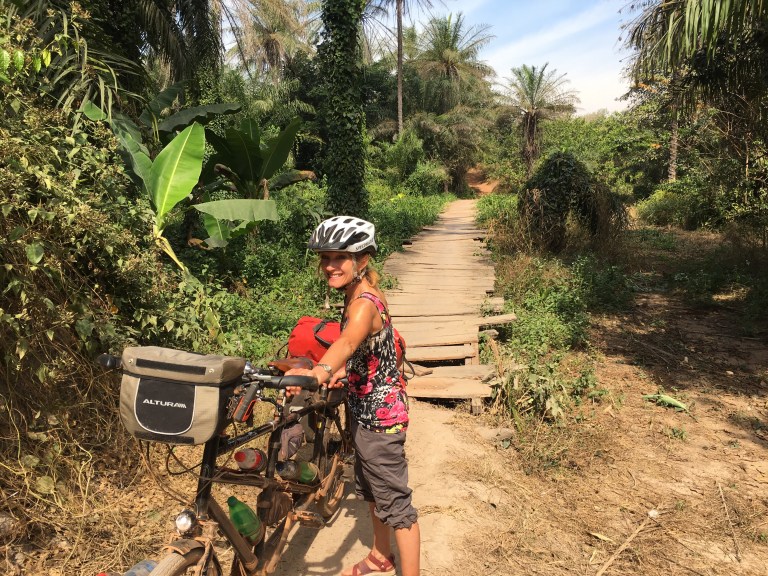
 The route was hard going, deeply rutted paths through lush green tropical forest. It went on and on until eventually over a hill we got a glimpse of the wide river ahead through a gap in the large glossy leaved trees.
The route was hard going, deeply rutted paths through lush green tropical forest. It went on and on until eventually over a hill we got a glimpse of the wide river ahead through a gap in the large glossy leaved trees.
We joined a lorry that strained to board the little raft ferry. The winch was fired into action and we were slowly pulled across the wide expanse of the river set in in thick vegetation.
Eventually we reached the remote official place to get our passports stamped with entry into Guinea. A smiley, friendly chap wearing his military uniform sat in a simple shaded hut. He welcomed us and when saw we were British, immediately asked if we voted for Brexit. There was much comment and sadness on why was Britain doing this! A lone guy sitting in his hut in the jungle waiting for the very few people that use this route.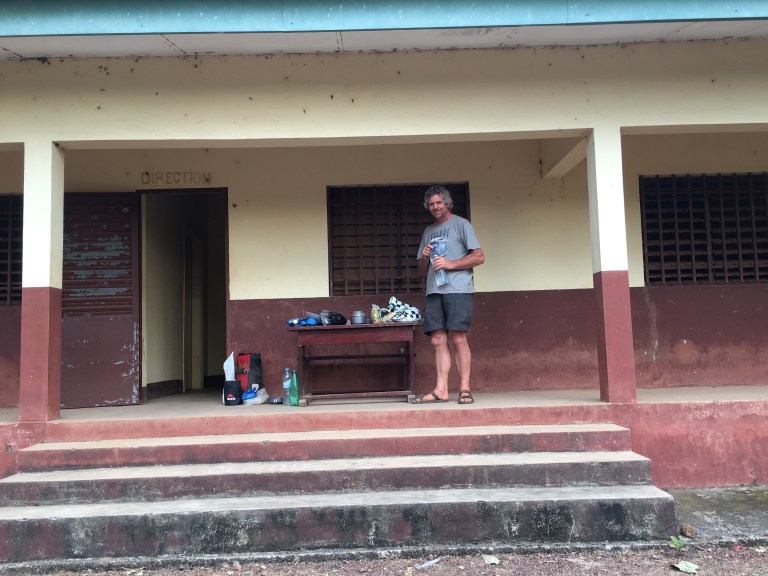
Time was marching on and when we reached the town of Dabiss we looked for a school to stop the night. A warm friendly English teacher made us very welcome and we put our inner tent up in one of the school rooms. The school had pit latrines, but no water or electricity. Once our tent was up we headed off to the well back in the town to collect water for washing and start the routine of filtering drinking water for that night and the next day. Trips to the well or pump are always a little event, with many people congregating there, laughing and chatting away in an animated way. Maybe it’s all the gossip that is being exchanged. It would be nice to be able to understand what was being said. They were always a nice social , bonding time, as everyone helped each other fill their containers and pots.
The next morning we were asked to chat to the different classes at the beginning of the school day which was the least we could do in repayment for their kindness.
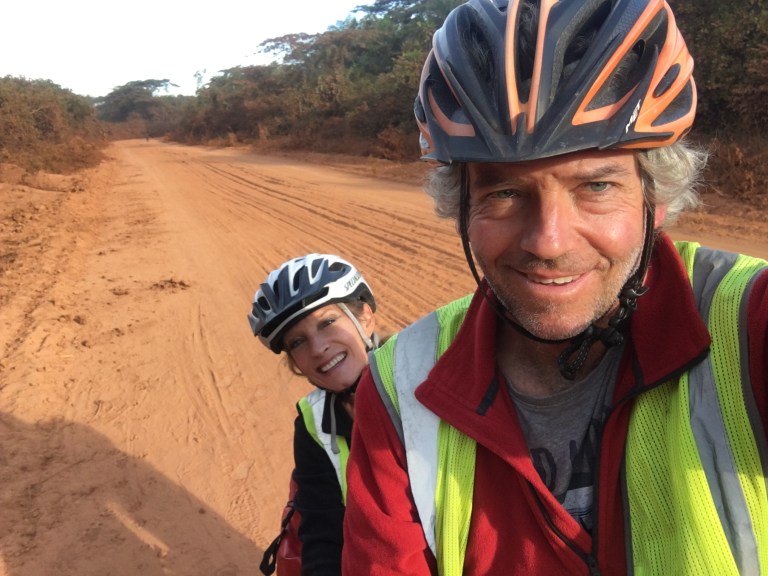 Back on the road to Boke which had improved a lot now, the French overlanders caught up with us. It had taken more than a day for them to catch us as the road over the border from Guinea-Bissau was so bad. They stopped and there were many hugs and kisses and then we waved them on their way.
Back on the road to Boke which had improved a lot now, the French overlanders caught up with us. It had taken more than a day for them to catch us as the road over the border from Guinea-Bissau was so bad. They stopped and there were many hugs and kisses and then we waved them on their way.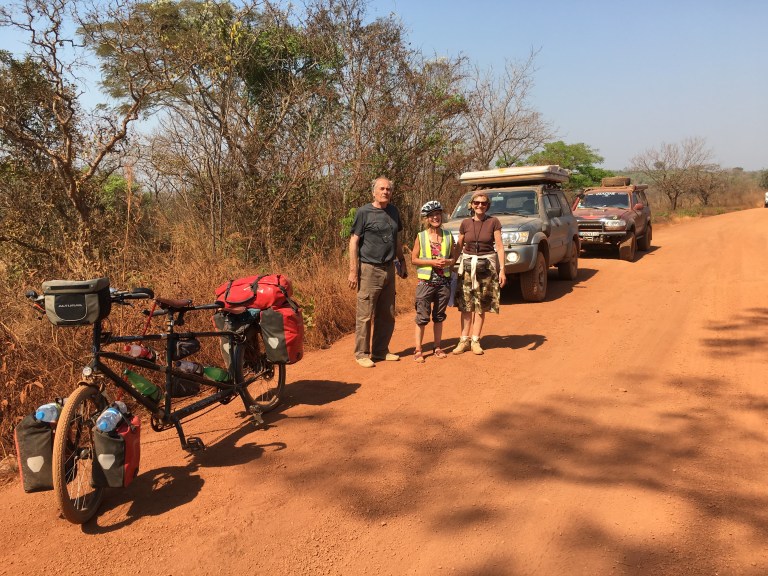
Always with a new country you notice the differences with the country you have just left. Guinea seemed quite a lot poorer and wells and pumps were harder to find. Nearly all the houses were simple, round mud and with grass thatched roofs. The people were very friendly and surprisingly there were a lot more smart phones about.

The next day we started to head towards the Highlands of Guinea. A very good tarmac took us to Sangaredi, the centre for bauxite extraction. Suddenly we were in a different world. Smart white pick ups with people wearing hi vis and hard hats. There was order and more wealth. We met European characters who had spent a lot of their life working on projects in Africa. Guinea has the largest bauxite reserves in the world and could become a very wealthy country. Interestingly we met Barbara a German lady who was campaigning for villages land rights as the mines claim more of the land. All nationalities are here getting a slice of the action, but what about the herdsman and his little village as multi national mining companies sweep through.
The landscape was barren, quite lunar in its appearance. It made for a really harsh, rocky ride to Telemele where the highlands start. We climbed and climbed on jagged rocks with very little shade. The route was horrendous, so rough, we worked hard to gain little progress. We had left the bauxite area and were now in a remote harsh landscape with just a few simple villages. We had to be careful to take on enough water when there were wells and pumps, which were becoming a scarcity.
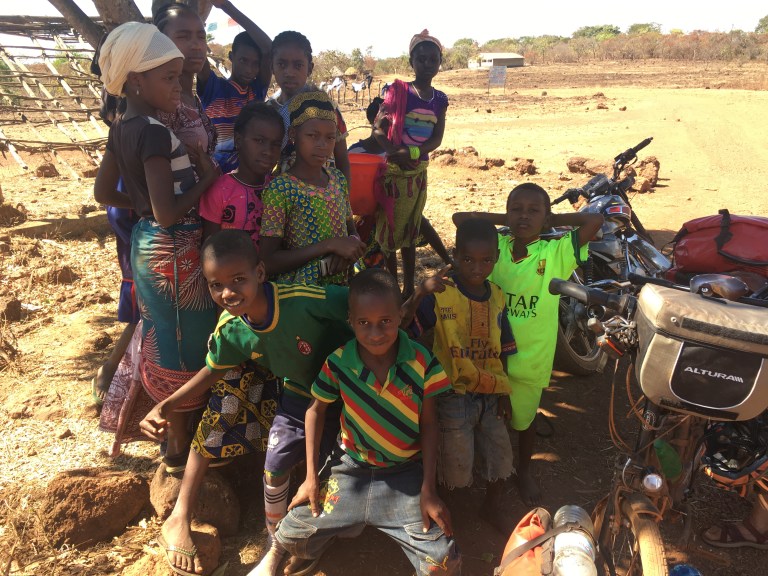
Eventually after 11 hours of toil to cycle 43 miles we reached Konsotomy, a larger village with a market. We camped in the Sub Chiefs compound.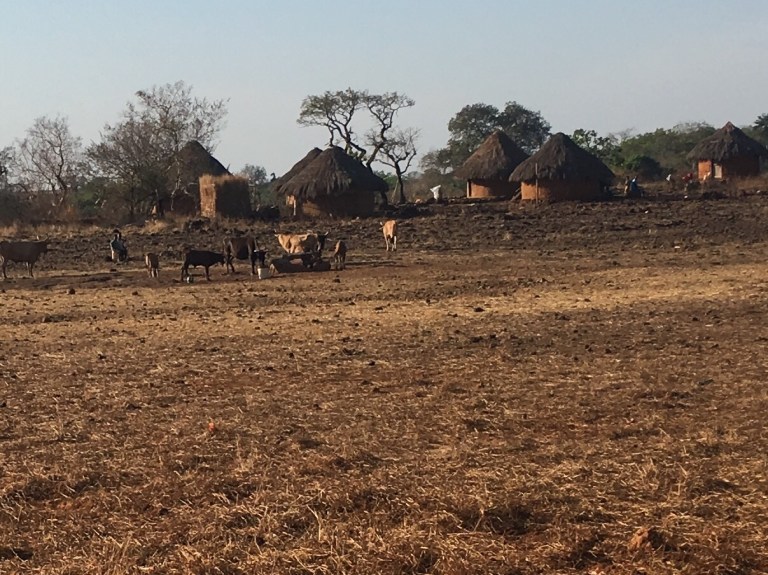
The next day the barren landscape continued with occasional remote isolated villages of a few small round mud huts, a goat or two and perhaps a cow.
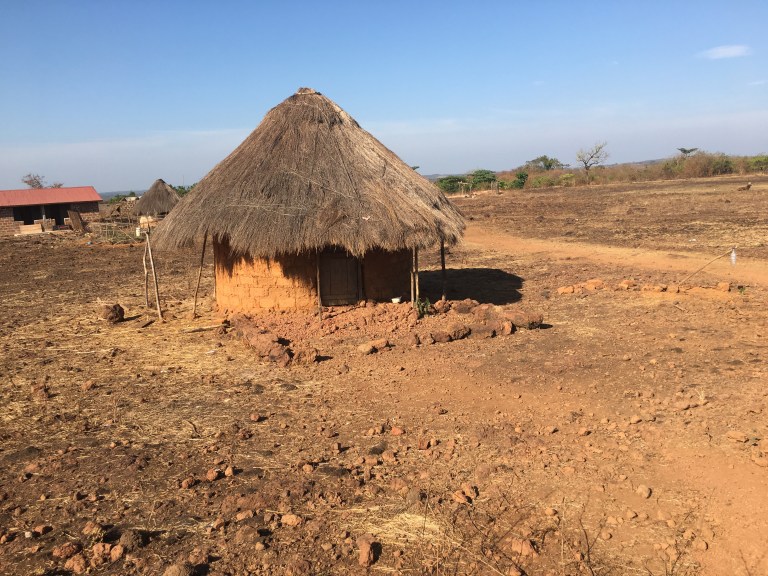
 As views of craggy escarpments came into view, towering in the distance we dropped down to join a river valley. There was vegetation again, lush green and overwhelming. Water could be heard from deep in the forest, tumbling over boulders. It was a refreshing sound and the route became more manageable.
As views of craggy escarpments came into view, towering in the distance we dropped down to join a river valley. There was vegetation again, lush green and overwhelming. Water could be heard from deep in the forest, tumbling over boulders. It was a refreshing sound and the route became more manageable.
 The track started to climb and we new we would need to stop in a village for the night as Telemele was not achievable today.
The track started to climb and we new we would need to stop in a village for the night as Telemele was not achievable today.
A very small village came up and after the usual exchanges we asked if we could camp somewhere. A lovely old man, Mohamedadu, so kindly offered us his hut.

We chose the tent as it makes for a better nights sleep and you tend not to get rats scurrying around, but we were touched by his generosity.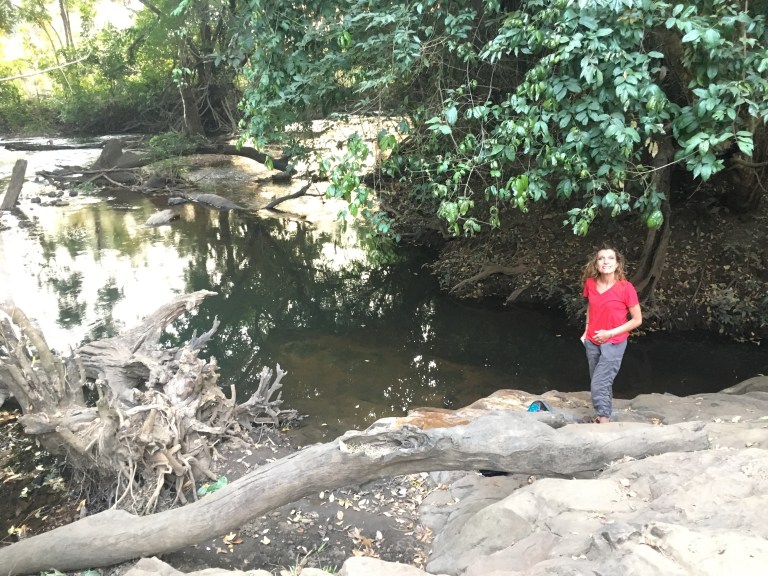
The village had no well and a ten minute walk to a beautiful shaded creek set among large boulders, was our point for washing and water collection. It was nice to be able to wash in unlimited water, rather than be restricted to what we were able to carry from the pump or well.
Lovely Mohamedadu, father and grand father to many. It got quite complicated to work out how many. All the village seemed to be related to him. A flock of grand children gathered round him as he showed us a place to camp. Such an unassuming gentle man who was so pleased to have us camping in his small newly planted plantation. Someone we will never forget. In the morning we used our excess water to irrigate his plants.
The flat topped towering escarpment ridges got closer and larger. Stratified with long deep narrow crevices. The Highlands loomed ahead of us.
 The thick of the Highlands were off our route so we decided to have a day off cycling and sorted out a car to do a trip into the mountains and try and see one of the spectacular waterfalls that the region is famous for.
The thick of the Highlands were off our route so we decided to have a day off cycling and sorted out a car to do a trip into the mountains and try and see one of the spectacular waterfalls that the region is famous for.
I had seen this huge waterfall on a satellite picture and heard of people walking to it from the north east when they follow the Fetore river.
It looked possible to approach it from the south, but when asking around no one had heard of it. Boldly we sorted out a car to take us to the trailhead where it looked like you could follow the river on foot. After some negotiation a young lad and his mechanic friend with a Nissan Micra that had seen better days, took on the job of heading off on rough tracks to a location they didn’t know existed. I was able to guide them from a satellite map app. As the road got rougher, narrower, overgrown, rivers forded, rivers crossed on rickety plank bridges our two friends became rather quiet and kept asking for reassurance we were heading the right way. The Micra twisted, buckled and rolled its way through the bush following an orange track on the picture on my phone. We kept with it, although I was secretly doubting myself, but we pushed on. Still no one seemed to know the existence of this waterfall.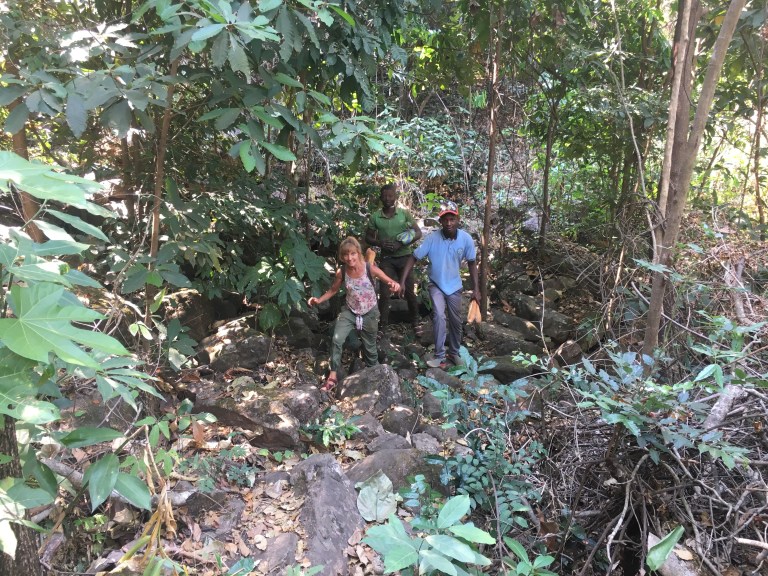
After three hours of driving when within five miles of the falls at a village we chatted to Mamaba, who was standing outside his compound. Thankfully he knew about it and agreed to show us the way. We set off up and over rocky hills and worked our way up the river, leaping from boulder to boulder as we crossed the fast moving water. The valley was full of thick vegetation, and the roar of the river echoed the rocky escarpments. The trail went on and on and we became worried that we weren’t carrying enough water. A long chunky snake scurried off from where it was lying to the path side, certainly the biggest one I have seen. We had to get there as we had gone so far. The going was tough as we scrambled up and down the river bank.

Eventually nearly at the point of turning back, a glimpse through the vegetation near the skyline, water cascading from the cliff top. As we turned the next few corners leaping from one boulder to the next, there it was in full glory. Tumbling from the sheer cliff, bouncing on a rock outcrop before plunging into the pool below, causing small waves across the waters surface and filling the air with a fine mist, that was refreshing and cool after our toil of finding the cascade that no one knew existed.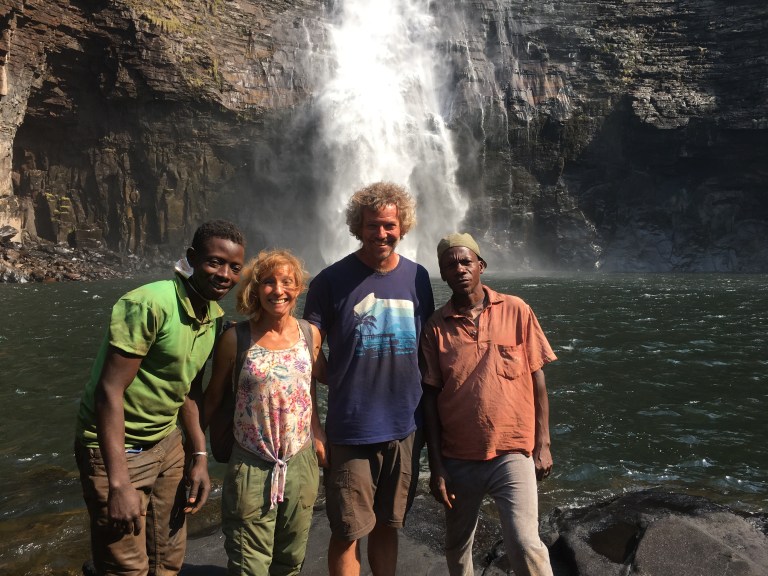
Back at Mamaba’s house, his family waiting for his return, he presented us with a whole bucket of oranges as a gift. Such kindness from this lovely man that we will never forget.




Hi Dave and warty. I managed to subscribe to your blog so it sends me a message when you post. Magic
Glad you made it to the waterfall. Looks amazing. I hear from the more modern people that you are ill. Hope it’s not serious. Look after yourselves. If you need anything, give me a shout and I’ll pop over with it. Lots of love
LikeLike
Thanks Simey, lovely to hear from you. Still got the shits but back on the road today. There is a lot of countryside!
LikeLike
You are both so brave! lovely commentary, spectacular scenery what memories. I have have shared this with my stepson who is a film/director who make your sorts of documentaries, he last comments on the last up load was you are going to somewhere he would like to visit!
keep save
Geraldine x
LikeLike
Thanks Geraldine, we love sharing our experiences. It’s part of the trip. X
LikeLike
Caught up with you again, excellent pictures,the waterfalltrip sounded adventuous but then it all is to to us,hope you have recovered.
LikeLiked by 1 person